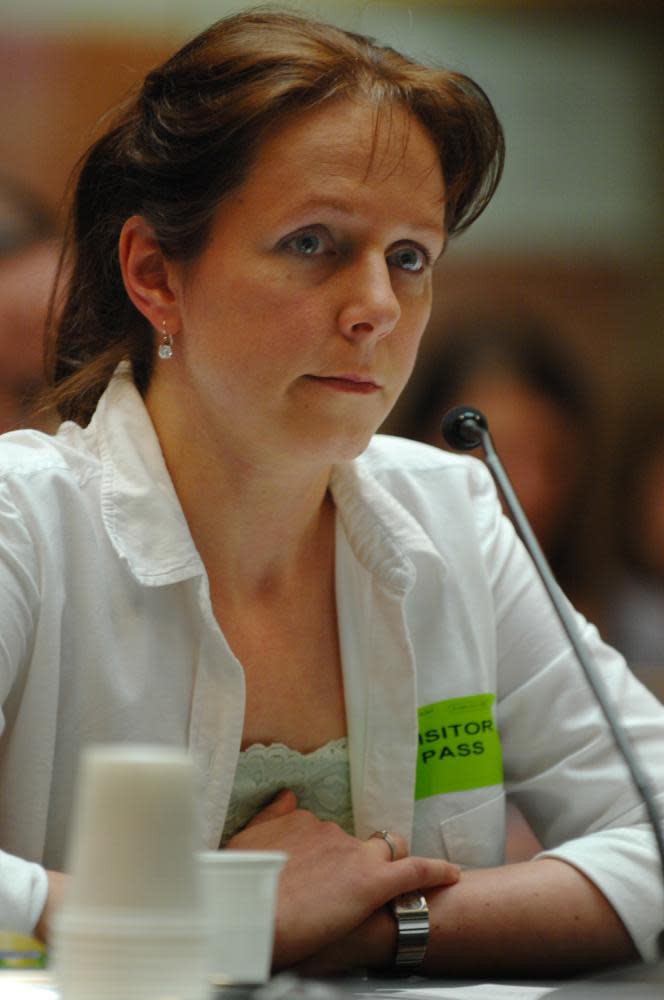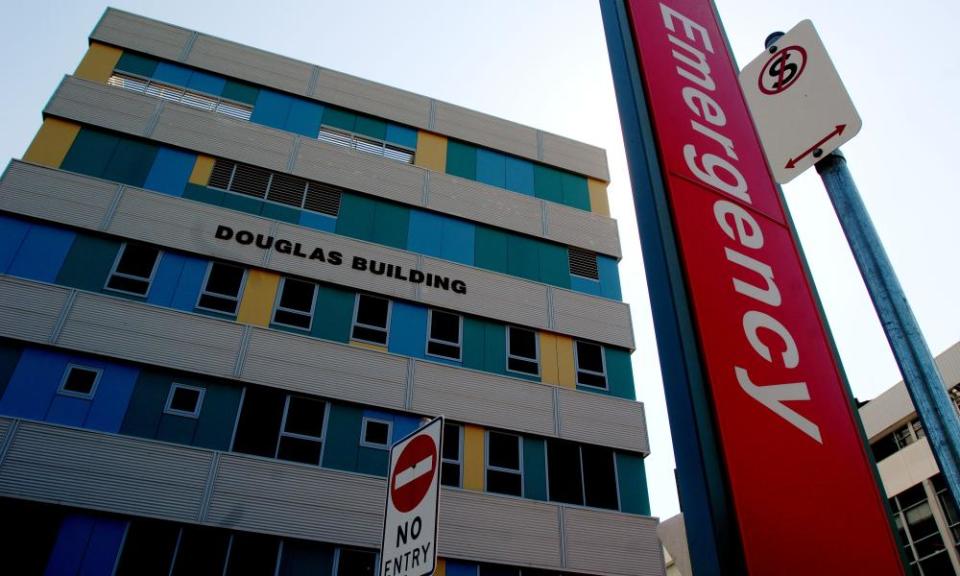‘Just a miscarriage’: has anything improved in NSW since Jana Horska’s shocking experience in 2007?

Fourteen years ago, Jana Horska had a miscarriage in a toilet at Sydney’s Royal North Shore hospital after waiting for hours, in pain, with no assistance or information from staff.
She was 14 weeks pregnant.
The horror of Horska’s experience led to a New South Wales parliamentary inquiry that made a number of recommendations around miscarriage care, including the establishment and monitoring of Early Pregnancy Assessment Services (Epas) in public hospitals across the state.
But more than a decade later, NSW Health has batted away questions about how those services are functioning, overseen, staffed and whether they are meeting best practice guidelines.
Australia doesn’t gather miscarriage data, but early pregnancy loss is thought to affect between 102,000 and 150,000 families a year. Somewhere between 35,000 and 74,000 patients are admitted to hospital for treatment across the country.
Multiple obstetricians have told Guardian Australia that while some Epas units provide exceptional care, especially those in large tertiary hospitals, not all are operating as they should – particularly in regional areas.
Horska is calling on NSW Health to show transparency around measures that were put in place around early pregnancy loss following the inquiry sparked by her experience.
‘It’s difficult to revisit’
Horska still thinks regularly about what happened to her that night in 2007. She now wrestles with how much of the detail to share with her living children, especially her oldest, a 12-year-old daughter.

“They don’t tend to ask you questions when you’re ready for it. Sometimes it’s quite difficult to go back to and I’m not ready to talk about it,” she explains.
Horska had already had one miscarriage when she started to experience bleeding and cramping during her second pregnancy. In a panic, she called her previous obstetrician back in Slovakia.
“He told me just go to the hospital, they’ll put you on a drip and bedrest and you will see what happens. I went to the hospital and the first thing I remember is that there weren’t many people in the waiting area and I thought that was a good sign.”
Horska filled out the forms and waited. And waited. And waited.
“I was just getting more and more pain. I was having contractions, but I didn’t know that’s what it was. Eventually, a nurse came and asked me if I had a pad on. I said yes, I did. They took my temperature.”
Horska then went from sitting on a chair to squatting on the ground as the pain became overwhelming. Between contractions, she went to the toilet.
“When I got there, I sat down and I had this urge to push. I just couldn’t help it. And then the baby just fell in my hands. I was in such a state of shock. I grabbed the wet floor signs from in front of me and I just smashed it against the window and I started yelling out for my husband.”
Horska was moved immediately in a wheelchair from the toilets to a bed, her son in between her legs. Still in shock and still waiting for a specialist to see her and explain what had happened, she was told by a nurse: “Don’t worry, my mother’s had heaps of miscarriages.”
Horska’s story was leaked to the press and outrage ensued along with a wave of further complaints about treatment at Royal North Shore hospital, which was underfunded and stretched to breaking point.
Horska, along with her husband, testified at the parliamentary inquiry, which also heard from another patient, who experienced a similar lack of care, sympathy or understanding from emergency department staff.
Having miscarried before, that patient knew the loss was imminent, and demanded a seat inside the department itself so she did not have to miscarry her baby in “a room full of strangers” in the waiting area. She ended up miscarrying her baby into a toilet at 14 weeks – just like Horska.

A plan for ‘rapid assessment and advice’
One of the key recommendations of the inquiry was the establishment of Epas units, which were to be reported on in the NSW Health annual report.
Commentary around the recommendations at the time of the inquiry and since acknowledge Epas units would not address all the issues relating to early pregnancy loss in the hospital system, but they were a solid start.
There was also hope that the Epas units would encourage communication between emergency physicians and people with specialist understanding of miscarriage and related trauma.
The health minister at the time, Reba Meagher, undertook to spend $4.5m in the 2007/08 financial year to implement the report’s recommendations.
Related: Air grievances: silence swirls around the toll of bushfire smoke during pregnancy
“Women with early pregnancy problems who present to an emergency department but do not need urgent medical attention will get rapid assessment and advice from new early pregnancy units, co-located within most emergency departments,” she said at the time.
The 2007/08 NSW Health annual report did report back on Epas units – in three paragraphs. It noted that new Epas units had taken the total number in NSW to 22, but there was no information about capacity, benchmarked standards of care or oversight. At the time, NSW had 228 public hospitals, of which 124 were major, large, medium or acute.
By 2009/10 and 2010/11 reporting had morphed into updates about general antenatal care offerings, and by 2011/12 there was no mention of early pregnancy care at all.
‘Darling, it’s just a miscarriage’
Earlier this year, Hannah* attended a hospital emergency department in Sydney after repeatedly calling the hospital’s Epas with no response.
“So we went to the emergency department, they gave me the painkillers and said call the clinic again [because] ‘they’re the ones that know what they’re doing’,” she says.
I just wanted it done. Over. I just wanted to escape that period of my life and start grieving
Rose
Finally, after again calling repeatedly, Hannah got a call back from the clinic.
“[The nurse from the Epas] was like, ‘What’s going on?’ And I said, ‘I’m having all of this pain.’ Basically, what I wanted to ask her was, if my husband leaves the house, is he going to come home and find me dead in the bathroom? That was where my brain was at because I’d never experienced anything like that … And she said to me, ‘Darling, it’s just a miscarriage.’”
Another patient, Rose*, experienced a miscarriage earlier this year. After her GP in coastal NSW confirmed the loss via an ultrasound, he referred her to the local Epas, which took three days to get back to her.
“When I went into the Epas, I was in the waiting room and I was seeing pregnant women everywhere, which was kind of shit,” she says.
Once Rose got into the clinic she says she “broke down”, but the service was good.
“The nurse was fantastic and so was the obstetrician,” she explains.
Rose opted for a surgical procedure to end the pregnancy. Usually she would have to wait up to two weeks, but by luck they were able to fit her in two days later. This still meant a total 10-day wait from the first confirmation of the miscarriage to bringing the pregnancy to a close.
“I just wanted it done. Over. I just wanted to escape that period of my life and start grieving,” she says.
The money for it ‘disappeared’
In 2012, NSW Health issued guidelines for the “management of early pregnancy complications”, which state that all maternity services must provide, or be networked to, a dedicated outpatient Epas, and that all Epas units should have an appointments system, a separate waiting area, an ultrasound machine (including transvaginal ultrasound) or access to these services, and easy access to laboratory facilities.
It further states that Epas should be available “on a daily basis during the normal working week and if possible, services available on weekends and after hours”.
But even the Epas clinic located within Sydney’s biggest hospital, Liverpool hospital in south-western Sydney, is only open 8am to 3pm, six days a week.
One obstetrician says their hospital in regional NSW does not provide a discrete waiting area, meaning like Rose, women attending with threatened miscarriage are often seated alongside heavily pregnant women.
“Some leave for that reason, or don’t attend, therefore [don’t receive] the care they needed,” the doctor says.
“We got an ultrasound machine and [NSW Health] is supposed to fund a midwife or nurse for four hours per day to be sitting there scanning and running the clinic,” another obstetrician, who works in regional NSW hospitals, says.
“The money for that nurse or midwife disappeared, so we have no nurse or midwife sitting in a clinic. Even though the funding was received, it’s just gone somewhere else. The ultrasound machine sits in another department.
“It’s supposed to be a one-stop-shop. They can get the scans done, get the social worker, get everything done in one place. But [patients] basically just rock up to the consult room, they see a registrar – no nurse and a midwife, no social worker – [and] if they’re lucky, they might get thrown a brochure.”
Related: A maddening grief: my year of miscarriages and how I got through it
Another NSW-based obstetrician says that while they have seen exceptional care at some clinics in the city, standards can vary markedly.
“Ultimately, it’s all about communication, what is happening and why. That’s why I find it so frustrating, because I think that is the role that [Epas units] are supposed to fill, but it doesn’t feel like the care is where it potentially could be.”
The president of the Royal Australian and New Zealand College of Obstetricians and Gynaecologists, Dr Vijay Roach, says early pregnancy complications, including miscarriage, are profound experiences for many people.
“We must ensure access to sensitive, skilled and timely assessment, and management, of those affected. The medical profession, health departments, and society as a whole, need to realise that these mothers, and their families, matter, and give them the care that they deserve.”
The guidelines for management of early pregnancy complications were due to be updated in August 2021, representing a fresh opportunity to address some of the issues around care during miscarriage and early pregnancy loss. NSW Health told the Guardian the document “remains current”, and the review will begin early next year.
In response to questions about how many Epas units are operating in the state, how they are staffed, how many patients are seen and who oversees them, NSW Health said “that information is not available”.
In a response to a list of follow-up questions about the issues raised in this story, NSW Health said Epas units were the responsibility of local health districts.
“Each Local Health District is responsible for managing and monitoring access to EPAS clinics. NSW Health does not provide a segregated budget for EPAS clinics. Local Health Districts are responsible for funding local EPAS provision within their overall budget allocation.”

 Yahoo Finance
Yahoo Finance 